Human parasites are commonly referred to as any organism that lives at their expense. These are bacteria, fungi, worms. Human parasites are divided into internal and external. The most unpleasant and greatest destruction of the body is caused by helminths - various parasitic worms.

Parasites and the human body
Creatures parasitizing the human body can be external or internal. External:
- Mosquitoes.
- Leeches.
- Lice.
- Scabies-causing microorganisms.
But there are many more beings who prefer to settle inside the body. These include:
- Bacteria.
- The easiest.
- Helm samples.
- Mushroom.
The external and internal organization of the parasite is among the simplest. Because they do not have to evolve to survive, their organization is greatly simplified.
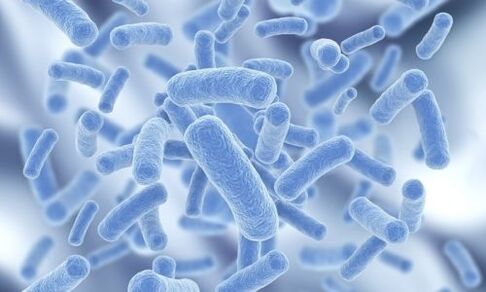
There are a lot of creatures that prefer to settle inside the body. For example, it could be a bacterium.
They cannot survive without a host because they are unable to obtain their own food. But all of them, without exception, multiply very rapidly, especially under the right conditions. Where they are not driven immediately.
They are geographically different. Some can be found everywhere, the climate does not hinder them. Others live exclusively in tropical countries, but the human body is easily brought to others. They also settle in different places in the body.
Luminal parasites are satisfied with the hollow parts of the body and the tissues live in the tissues.
The developmental cycles of parasites, especially helminths, are also varied. Some first develop in the ground (biohelminths) and then move to a living being. Others must first evolve in the body of all other living beings, but not humans. Again, others may be transferred to another as an adult or re-infect themselves.
It is a mistake to assume that infection can only occur with dirty hands. The eggs of some helminths are viable for six months outside the medium and adhere well to animal hair. Eggs also survive in an environment that is dangerous to them - if you cook meat or fish incorrectly, an entire worm colony can settle in you.

You may want to cook the meat incorrectly as an entire worm nest may settle within you.
Human endoparasites
Parasites are divided into endoparasites and ectoparasites. Endoparasites - those that live indoors, ecto - outside. Endoparasites are able to settle in almost every internal organ and tissue in the body. They are divided depending on the localization. Endoparasites:
- Endoparasites associated with internal organs associated with the external environment.
They settle in exactly the organs that are connected to the external environment, and not the other way around: the parasite organism does not choose to "breathe. " These organs include the intestines, lungs, and human urinary reproductive system. These are amoebas, worms, andparasite markers.
- Blood parasites.
They live in human blood. They can live in plasma, white blood cells, red blood cells. These are trypanosomes, microfilariae or hemosporidia.
- Tissue endoparasites.
Endoparasites that choose tissues in the body to live in. Muscle tissue, brain, cartilage, connective tissue. Even in nerve fibers, tissue endoparasites can settle. These are Finnish tapeworms, trypanosomes, myxosporidia, trichinae and others.
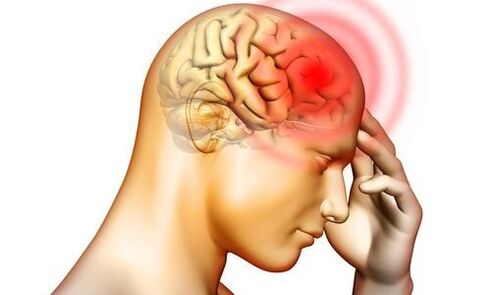
Endoparasites can choose the brain as their place of residence.
Determining the type of parasite according to the location of the localization is quite arbitrary. Many species are able to migrate through various internal organs and regularly traverse the body of the host. The reproductive process can take place in one place and the living things will exist and feed directly in another. The place where the parasitic creature settles and will be the place of its conditional localization.
Despite the simplification of many parasitic systems, their life cycles are quite complex.
Some species have to change many farmers during their lifetime, which may belong to different biological species. Others can only survive within one species, but an intermediate host may be needed. They reproduce in one person, develop in another and mature. With such a complex life cycle, their sexual functions increase significantly. To survive in the body, parasites need to multiply quickly and a lot.
Helm samples
There are three main types of worms, also called worms. It:
- Nematodes, these are roundworms.
- Cestodes, ribbon-shaped endoparasites.
- Trematodes, also known as flukes.

Geohelm samples begin to exist in the soil of the earth.
In addition, it can be divided according to the duration of the life cycle and the number of places passing by during the journey. There are three types:
Geohelmintus
"Geo" is the earth. These worms begin their existence in the soil of the earth, they are only able to infect a human after the stage of ripening. They don’t need an intermediate host, the eggs get into the soil along with the human feces. Until the larval stage, they develop exclusively during the warm season.
Such worms include globular worms, intestinal eels, nekator, whipworms.
The larvae of these parasites can enter the human body through unwashed vegetables or direct contact with the soil.
Biohelm samples
These are parasitic worms whose life stages go through multiple hosts. There may be two or more intermediate hosts, depending on the type of worm. Some parasites only change one person. Others use organisms from other biological beings for development before they finally enter the human body.

You can become infected through contact with pets or other people, as well as by consuming semi-raw meat. Biohelmed samples include bovine tapeworms, echinococcus, broad tapeworms, trichinae, and others.
Infectious worms
These worms need neither soil nor an intermediate host. They experience all stages of their life cycle in a single organization in a very convenient location. Larvae are excreted directly from the human body when in contact with household surfaces and other people, they spread freely.
Helminths can live in different organs and systems of the human body, migrating from one part of the body to another from time to time.
The list of diseases caused by helminths is very extensive. It is only possible to determine which parasites live in the body and which treatment can be started after all the tests needed to determine the type of tests have been performed.
Round worms
Nematodes, also known as nematodes, are the most common in the human environment. In total, more than 24, 000 nematode species live in the world.
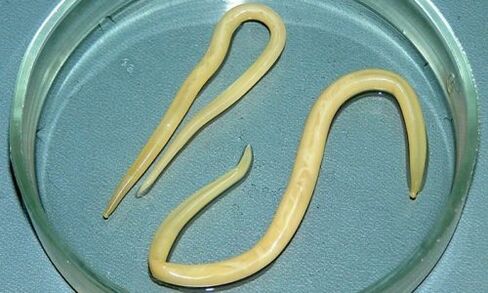
The most common human nematodes are roundworms.
Because of their shape, they are called round, which turns out when you make a cross section. The most common human nematodes are:
- Ascaris.
- Pinworms.
- Pea worm.
- Vlasoglava.
A helminthic infection known as ascariasis comes in direct contact with worm-infested soil or the consumption of unwashed fruits and vegetables. Parasites begin to develop in the intestines and then enter the human circulatory system, from where they enter various internal organs, heading for the oral cavity. A person, without noticing this, swallows the already grown parasite again. They feed on the remains of undigested food. Ascaris waste products are extremely toxic. There is no vaccine against ascariasis, the infection can only be prevented by following the rules of personal hygiene.
Pinworm infection is called enterobiasis. These are small worms (5-10 mm) that attach to the intestinal walls. They feed on blood and intestinal contents. Their eggs are placed under the skin, released from the anus while the owner is asleep. Itching causes a person to scratch the area of the rectum, the larvae get under the skin and on the hands, and can easily spread to other people in the house or in public places. There are no painful symptoms in enterobiasis; detection of pinworm infection in the initial stage is extremely problematic.
Trichinella, they are also trichinae, roundworms that choose an animal or person as their owner.
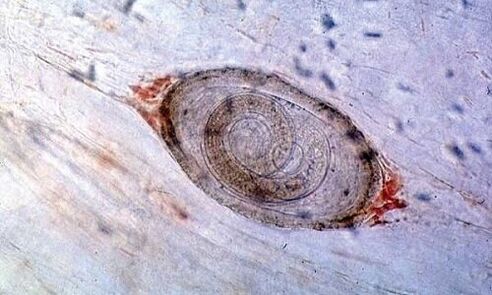
Trichinella is a parasitic worm that infects the human body, causing the trichinosis of the dangerous helminthic disease.
They begin to develop in the area of the striated muscles of the body and are then directed to the small intestine. In advanced infection, the muscle tissue can be about 15, 000 Trichina eggs per kilogram. These parasites have the potential to cause a deadly disease whose source is trichinosis.
Whipworms are so named because of their appearance. The front of their small body is fibrous, with an esophagus inside.
The back is wider and the other internal organs of the parasite are located inside. The whipworm can be up to 50 mm long. It feeds on blood and tissue fluid. Trichocephalosis causes the disease.
Tapeworms
There are about 3, 500 known tapeworm species in the world, also known as cestodes. These flatworms have no digestive system at all, and the diseases they cause are called cestodoses.
The most common cestodoses:
Cysticercosis
The disease is caused by larvae of the swine tapeworm that enter contaminated food from dirty hands.
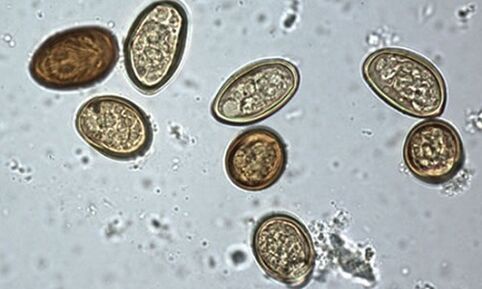
The disease affects the skin, bones, internal organs, brain and spinal cord. Most often, parasites are sent to the brain (in 60% of cases of infection). It is diagnosed based on the appearance of rounded formations on the skin. The disease is treated and the prognosis may be unfavorable in case of infection of the central nervous system.
Echinococcosis
It is localized in the liver, lungs, and many other internal organs. Echinococcus larvae excite the disease. They can develop inside a person over several years.
Infection occurs through contact with animals, picking berries and fruits, and drinking contaminated water.
The course of the disease is not very noticeable, it can develop over the years and it turns out that it can only be detected by accident.
Alveococcosis
Alveococcosis is caused by larvae of alveococcal worms. The disease is similar to echinococcosis but more severe. It affects the lungs and kidneys. Without treatment, the disease can most likely be fatal due to the development of liver failure.
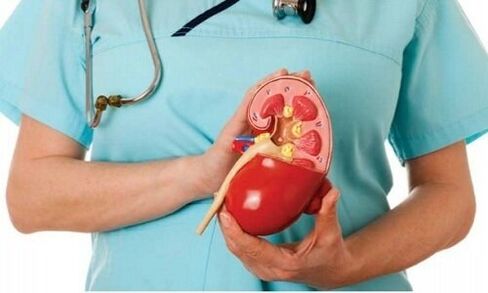
Alveococcosis most commonly affects the kidneys.
For teniarin
Teniarin production is caused by a bovine tapeworm. It parasitizes the tapeworm in the human small intestine, it develops over a period of 2, 5-4 months. The prognosis for treatment is often favorable. Parasites can get inside a person with infected raw or improperly heat-treated meat.
Tapeworms are extremely prolific. They have the least residual sensitivity and no digestive system at all. Such parasites cannot develop without a host.
Fluke worms
Flukek flukek. These are flat worms, resembling the elongated leaf of a tree in the shape of their bodies.
Some species of trematodes can be up to one and a half meters in size.
And in the human body, they are most often reached through fish or other seafood. About 7, 200 fluke species are known, 40 of which live in humans and cause trematodes, a serious disease caused by infection.
The most common flukes:
Liver layer
It is widespread globally and can exist in animals and humans. The biological life cycle is complex, with the parasitic host changing.
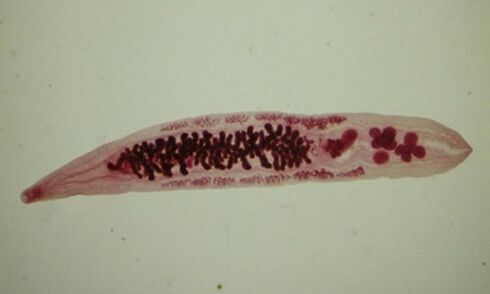
The most common placenta is liver flakes.
Schistosoma
Schistosome larvae can penetrate the skin or mucous membranes. The life cycle is complex, fed by blood. A female is able to produce about 3, 000 eggs a day, and the fertility of these parasitic worms is very high.
Other liver layers
They mostly cause opisthorchiasis, which causes helminthic disease that spreads to the liver. They are toxic to the human body.
The digestive system of fluke worms, and with it the reproductive and excretory system.
Other systems are evolving poorly. Trematodes feed on blood, skin epithelial cells, and intestinal contents. They can live almost anywhere: from the liver to the conjunctival sac of the eye.
Other endoparasites
The rest of the internal parasites are various bacteria that cause dangerous diseases, and with them the simplest microorganisms. The fungus that spreads inside the human body also belongs to the stage of endoparasites.
Many beneficial and harmful microorganisms live in the human body. Some of them cause quite dangerous diseases that can lead to death. It is not always possible to immediately detect the presence of parasitic creatures alone, but early diagnosis of infection provides a greater chance of complete recovery. If an invasion is suspected, we recommend that you undergo a full medical examination immediately.



































